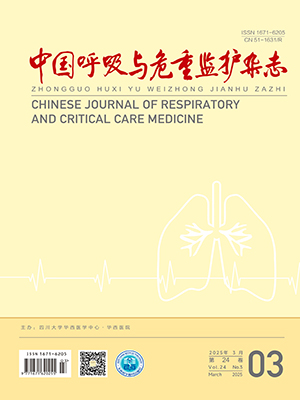| 1. |
Milewicz DM, Braverman AC, De Backer J, et al. Marfan syndrome. Nat Rev Dis Primers, 2021, 7(1): 64.
|
| 2. |
Groth KA, Hove H, Kyhl K, et al. Prevalence, incidence, and age at diagnosis in Marfan syndrome. Orphanet J Rare Dis, 2015, 10: 153.
|
| 3. |
Dietz HC, Cutting GR, Pyeritz RE, et al. Marfan syndrome caused by a recurrent de novo missense mutation in the fibrillin gene. Nature, 1991, 352(6333): 337-339.
|
| 4. |
Groth KA, Stochholm K, Hove H, et al. Causes of mortality in the Marfan syndrome (from a nationwide register study). Am J Cardiol, 2018, 122(7): 1231-1235.
|
| 5. |
Karpman C, Aughenbaugh GL, Ryu JH. Pneumothorax and bullae in Marfan syndrome. Respiration, 2011, 82(3): 219-224.
|
| 6. |
范永琛. 马凡氏综合征并发反复双侧张力气胸. 医师进修杂志, 1992, 15(8): 47.
|
| 7. |
高连增, 刘野樵, 李滨. 马凡氏综合征并自发性气胸1例报告. 黑龙江医药, 1993, (5): 49.
|
| 8. |
刘锡杰. 马凡氏综合征合并肺损害1例报告. 吉林医学, 1994, 15(3): 186-187.
|
| 9. |
陶林森. 马凡氏综合征并自发性气胸2例报告. 综合临床医学, 1994, (5): 56.
|
| 10. |
方向宏. 马凡综合征并发自发性气胸2例. 安徽医科大学学报, 1995, 30(2): 142.
|
| 11. |
齐淑芹, 廖文召, 张建波, 等. 马凡氏综合征并自发性气胸1例. 牡丹江医学院学报, 1996, 17(3): 45-46.
|
| 12. |
商鸣宇, 高元明, 高明哲, 等. 马凡综合征合并气胸一例报告. 北京医学, 2003, 25(1): 12.
|
| 13. |
刘广源, 沈建雄, 邱贵兴. 马凡综合征合并脊柱侧弯术后自发性气胸一例报告. 脊柱外科杂志, 2004, 2(5): 310-313.
|
| 14. |
梁延东, 黄澂. 马凡综合征并自发性气胸二例报告. 北京医学, 2005, 27(1): 24.
|
| 15. |
高峰, 曲建昌. 马凡氏综合征罕见并发症1例. 临床肺科杂志, 2005, 10(4): 424.
|
| 16. |
叶桃春, 孙志佳, 李京伟, 等. 反复发作性自发性气胸的马凡综合征1例. 广东医学, 2010, 31(23): 3066.
|
| 17. |
林慧, 钟殿胜. 马凡综合征并发自发性气胸一例. 天津医药, 2012, 40(10): 1085+1090.
|
| 18. |
赵年, 卢旭东, 夏菁, 等. 以反复气胸发作为表现的马方综合征一例并文献复习. 中国呼吸与危重监护杂志, 2015, 14(4): 392-394.
|
| 19. |
王峥乔. 马凡综合症合并自发性气胸病例报道一例及文献复习. 中国医科大学, 2018.
|
| 20. |
Wood JR, Bellamy D, Child AH, et al. Pulmonary disease in patients with Marfan syndrome. Thorax, 1984, 39(10): 780-784.
|
| 21. |
Hall JR, Pyeritz RE, Dudgeon DL, et al. Pneumothorax in the Marfan syndrome: prevalence and therapy. Ann Thorac Surg, 1984, 37(6): 500-504.
|
| 22. |
Sunouchi T, Watanabe Y, Tomonaga K, et al. Optimal treatment of pneumothorax in adolescents with Marfan syndrome. J Pediatr Surg, 2021, 56(7): 1103-1106.
|
| 23. |
Matsumoto T, Uto K, Oda H, et al. Pleural changes in patients with pneumothoraces and Marfan syndrome. J Thorac Dis, 2020, 12(9): 4877-4882.
|
| 24. |
Scott RM, Henske EP, Raby B, et al. Familial pneumothorax: towards precision medicine. Thorax, 2018, 73(3): 270-276.
|
| 25. |
Hallifax RJ, Goldacre R, Landray MJ, et al. Trends in the incidence and recurrence of inpatient-treated spontaneous pneumothorax, 1968-2016. JAMA, 2018, 320(14): 1471-1480.
|
| 26. |
Hu XW, Zhang GF, Chen XM, et al. Birt-Hogg-Dubé syndrome in Chinese patients: a literature review of 120 families. Orphanet J Rare Dis, 2021, 16: 223.
|
| 27. |
Gilday C, Odunayo A, Hespel AM. Spontaneous pneumothorax: pathophysiology, clinical presentation and diagnosis. Top Companion Anim Med, 2021, 45: 100563.
|
| 28. |
Neptune ER, Frischmeyer PA, Arking DE, et al. Dysregulation of TGF-β activation contributes to pathogenesis in Marfan syndrome. Nat Genet, 2003, 33: 407-411.
|
| 29. |
Yu J, Park J, Lee J, et al. Preoperative bullae and subsequent pneumothorax in 6605 patients who underwent robotic prostatectomy. J Anesth, 2022, 36(6): 740-746.
|
| 30. |
丁文泽. 胸廓影像学测量数据与原发性自发性气胸的相关性研究. 大连医科大学, 2021.
|
| 31. |
张其刚, 谭胜, 张晓峰, 等. 扁平胸廓青少年自发性气胸发病原因的生物力学研究. 中华胸心血管外科杂志, 2005, 21(3): 163-165.
|
| 32. |
Parlak M, Uil SM, van den Berg JW. A prospective, randomised trial of pneumothorax therapy: manual aspiration versus conventional chest tube drainage. Respir Med, 2012, 106(11): 1600-1605.
|
| 33. |
Liu YG, Xing HJ, Huang Y, et al. Familial spontaneous pneumothorax: importance of screening for Birt-Hogg-Dubé syndrome. Eur J Cardiothorac Surg, 2020, 57: 39-45.
|





 Baidu Scholar
Baidu Scholar